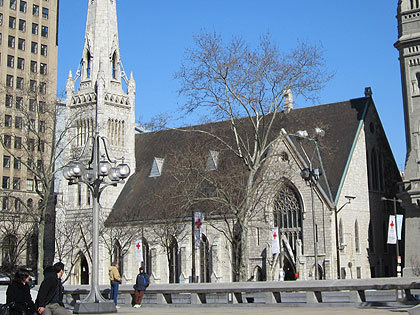Ever since its completion in 1865, the gleaming white spire of Arch Street United Methodist Church has been a familiar part of Philadelphia’s Center City skyline. Located just one block north of City Hall, the congregation has established an evolving, collaborative relationship with the city’s elected leaders, urban developers, and community service providers to address some of Philadelphia’s most pressing social problems.
Over the past several years, the congregation has watched as the neighboring Convention Center has expanded and adjacent properties have been repurposed to cater to this booming population. Yet, with an asset-based approach to its location and its work as a congregation, Arch Street UMC has established itself as an active and vital participant in the opportunities of Center City.
Community Connections
Arch Street United Methodist Church’s Gothic Revival building is one of the few churches left in the heart of Center City. Designed by Philadelphia Quaker Addison Hutton early in his career, the chapel was completed in 1865, and the sanctuary was finished five years later to accommodate a booming congregation. According to architect Shawn Evans with Atkin Olshin Schade Architects, the building was a departure from the tradition of simpler Methodist houses of worship: “Arch Street is an exuberant building with gleaming white marble, and it was shocking when it was built. It was something new in faith and civic life.”
The Reverend Robin Hynicka, Arch Street UMC’s pastor, adds, “This place was here before City Hall, here before the municipal center, here before the Masonic Temple — there’s something foundational about this building being first and still in Center Square.”
Given the 145-year-old congregation’s proximity to City Hall, the Mayor’s Office regularly invites it to participate in the focus groups that are organized for social programming, including the Mayor’s Task Force and 10-Year Plan to End Homelessness that was launched in 2005. Out of this task force and plan, a partnership emerged with the local nonprofit Project H.O.M.E., giving rise to the Grace Café at Arch Street UMC, which provided shelter for the homeless during the winter months for several years. In recent months that program has become a Sunday evening opportunity to share faith and company, including a full meal, music, and entertainment. Despite the program’s new format, the initiative marks the continuation of Arch Street UMC’s crucial response to Philadelphia’s social needs.
New Dollars/New Partners
With such congregational strengths and its significant building, Arch Street UMC was a clear candidate to participate in Partners for Sacred Places’ New Dollars/New Partners training program.
Prior to joining forces with Partners, Arch Street UMC had prepared a master plan based on four principles for improvements: making the building more safe and accessible; enhancing the building’s entrances and welcome; improving the internal fellowship; and supporting other local programs. Having identified these priorities in its Master Plan, “[The training program] was a great way to refine our next steps,” says Reverend Hynicka.
Throughout the training process and in the time since it graduated, Arch Street UMC has benefited from New Dollars’ principles and the clear set of assignments that help each congregation assess its assets and prioritize its goals. Reverend Hynicka articulates, “What Partners’ program does is it not only gives you the tools, but it holds you accountable for the use of the tools. [New Dollars] builds confidences, familiarity, and clarity on your team, and it’s indispensable. If I had to organize all of this, I wouldn’t have the time.”
The church’s architect, Shawn Evans, affirms the congregation’s successes: “It was readily apparent to the architects that the training had prepared the congregation well for the types of discussions and decisions and priorities that need to be made.”
Be InSpired
Since graduating from the New Dollars program in 2006, Arch Street UMC has launched its “Be InSpired” capital campaign and has made much progress in addressing the building’s most pressing needs. With clear planning for its capital projects and a healthy internal capital campaign, the congregation applied in 2007 for a grant from Partners. Their $100,000 grant (matched by another $100,000 in support from the congregation) will address various life-safety improvements in the building as well as the restoration of its striking Arch Street rose window. The congregation will then turn their financial commitment to the 200-foot spire, which is in need of rehabilitation and repair.
Evans has been enthusiastic about the congregation’s goals since the early stages of planning, since this restoration campaign is integral “for the congregation to keep growing and filling its own spiritual needs, which is important [as they] provide those social services that they’re called to face.”
Arch Street United Methodist Church continues to find new ways to partner with its neighbors. In 2008, the congregation received a $10,000 grant from Partners to work with the Community Design Collaborative to create a conceptual streetscape design for the area surrounding the church. The planning process, which took place over several months, engaged neighboring businesses and organizations — including the Salvation Army, Fabric Workshop, Reading Terminal, and Philadelphia Green — in a discussion of shared vision for the community.
The approach has been consistent with Arch Street UMC’s role as a proactive host for the dialogue among Center City stakeholders. As Reverend Hynicka puts it, “We want to have an organizational role. And having those relationships early on signifies that you want to be a neighbor, not a nemesis.”
An Evolving Community of Faith
In the coming years, the congregation at Arch Street United Methodist Church hopes to extend and enhance its place in the heart of Center City Philadelphia. As the host of vibrant civic dialogue and initiatives, the church has positioned itself at the forefront of the public approach to social concerns. Now, with a Master Plan in place and a restoration campaign underway, Arch Street UMC looks forward to asserting itself once again as a crucial presence on the city’s skyline and on the ground.

